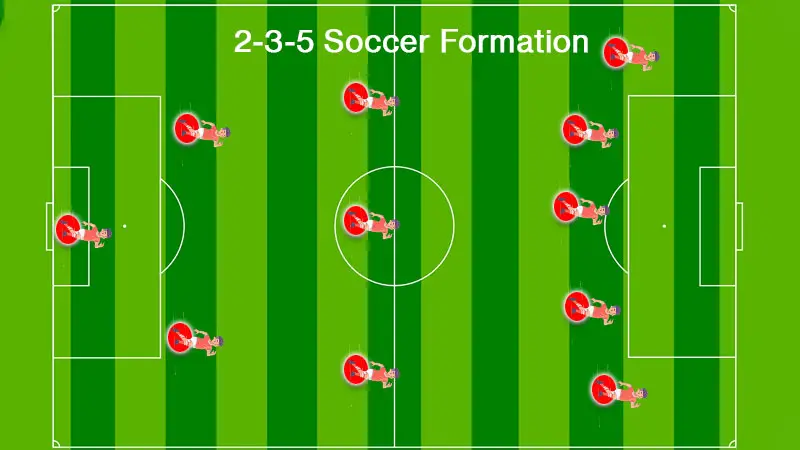The 2-3-5 soccer formation, often called the “Pyramid,” stands as one of the most historic and influential setups in the beautiful game’s evolution. Emerging in the late 19th century, it revolutionized how teams approached both offense and defense.
With two defenders, three midfielders, and five forwards, this formation emphasizes aggressive attacking play and fluid movement.
Despite its age, the 2-3-5 formation still offers valuable lessons for modern soccer strategies. Its focus on width and forward pressure can overwhelm opponents and create numerous scoring opportunities.
Understanding this formation provides a deeper appreciation of soccer’s tactical heritage and its impact on contemporary playing styles.
Evolution of the 2 3 5 Soccer Formation
The 2-3-5 soccer formation, or “Pyramid,” emerged in the late 19th century, revolutionizing tactics with its aggressive attacking play and laying the groundwork for modern soccer strategies.
Origins and Early Use
The 2-3-5 formation, also known as the “Pyramid,” began in the late 19th century. Scottish teams first popularized it around the 1870s. This setup, with two defenders, three midfielders, and five forwards, shifted the focus to attack-heavy play.
Teams using the Pyramid aimed to overwhelm opponents with numbers in the front line, creating both scoring opportunities and crowding the opposition’s defense.
Transition in Soccer Tactics
As soccer evolved, so did its tactics, and the 2-3-5 formation saw several transitions. By the 1920s and 1930s, teams started prioritizing more balanced formations. The shift to a stronger defense led to formations like the WM (3-2-2-3) and later the 4-2-4.
This evolution included pulling forwards into midfield or defense responsibilities, adjusting the tactical focus from purely offensive play to a more integrated approach.
Characteristics of the 2 3 5 Formation
The 2-3-5 formation, known as the “Pyramid,” focuses on an aggressive attacking style with its unique arrangement of players.
Player Roles and Responsibilities
The 2-3-5 formation’s player roles and responsibilities emphasize a clear division between attacking and defensive duties, ensuring fluid transitions and effective team coordination.
- Defenders: The two defenders, or fullbacks, provide the first line of defense and cover opposing attackers.
- Midfielders: The three midfielders play a crucial role in both defense and attack. They help transition the ball from defense to the forwards.
- Forwards: The five forwards aim to overwhelm the opposition’s defense, creating numerous scoring opportunities.
Strategic Advantages
The 2-3-5 formation offers several strategic advantages, emphasizing aggressive attacking play, effective use of width, and creating numerical superiority in the attacking third.
- Attacking Focus: With five forwards, this formation is highly aggressive, maximizing goal-scoring chances.
- Width Utilization: By spreading players across the width of the pitch, this formation uses space effectively, stretching the opponent’s defense.
- Numerical Superiority: This formation often creates mismatches, providing numerical superiority in the attacking third.
- Defensive Vulnerability: Only two defenders can leave the team exposed to counterattacks.
- Midfield Balance: The formation’s three midfielders need exceptional stamina and skill to maintain balance between attack and defense.
- Modern Adaptations: In today’s game, the 2-3-5 can be outdated and risky against formations prioritizing defense and midfield control.
Comparing 2 3 5 to Modern Formations
Modern soccer tactics have evolved significantly, yet the basic principles of the 2-3-5 formation still find parallels in contemporary strategies. This section will explore both similarities and differences.
Similarities with Contemporary Strategies
Modern formations echo the 2-3-5’s emphasis on width utilization, attacking overload, and fluid positional rotations to disrupt defenses effectively.
Utilizing Width
Modern formations like 4-3-3 and 4-2-3-1 employ wingers to stretch the defense, similar to the five forwards in the 2-3-5 setup. Wide players in these formations serve dual roles, maintaining width and providing defensive support.
Attacking Overload
Teams now use numerical superiority in attack through overlapping full-backs and high-pressing forwards, a concept echoed in the 2-3-5’s aggressive positioning of forwards. This overload creates more opportunities in the attacking third.
Positional Rotation
Like the 2-3-5, modern strategies involve constant movement and interchange of positions among the forwards and midfielders. Teams use fluid front lines to disrupt defensive structures, emulating the fluidity of the old Pyramid formation.
Differences and Tactical Shifts
Modern formations differ from the 2-3-5 by prioritizing defensive stability, midfield control, and strategic pressing to counter defensive vulnerabilities.
Defensive Stability
Modern formations prioritize defensive solidity. Formations such as 4-4-2 and 4-2-3-1 balance attack and defense better than the 2-3-5, which leaves only two dedicated defenders against counter-attacks.
Midfield Control
Current tactics emphasize midfield dominance and controlling the tempo. Formations like 4-3-3 stack the midfield with technically skilled players, contrasting with the 2-3-5’s three central midfielders who had both defensive and offensive duties.
Pressing and Counter-Pressing
Modern teams employ high pressing and counter-pressing strategies to regain possession swiftly, minimizing defensive vulnerabilities. The 2-3-5, focusing on attacking thrusts, often struggled with quick turnovers and defensive transitions.
Frequently Asked Questions
How did the 2-3-5 formation influence modern tactics?
The 2-3-5 formation influenced modern tactics by emphasizing width, attacking overload, and positional rotation. These principles are still seen in contemporary formations such as the 4-4-2 and 4-3-3, which have adapted these attacking strategies with added defensive solidity and midfield dominance.
What are the main weaknesses of the 2-3-5 formation?
The primary weaknesses of the 2-3-5 formation include its defensive vulnerability and the challenge of maintaining midfield balance. With only two defenders, it is susceptible to counter-attacks, and the three midfielders must work hard to support both defense and attack.
How does the 2-3-5 formation compare to the 4-3-3 formation?
The 2-3-5 formation emphasizes aggressive attacking through numerical superiority in the attacking third, while the 4-3-3 formation provides a more balanced approach. The 4-3-3 offers better defensive stability, stronger midfield control, and effective pressing strategies compared to the 2-3-5.
What was the historical significance of the WM formation in soccer?
The WM formation is historically significant as it marked a transition from the 2-3-5 to more balanced strategies. Developed by Arsenal’s Herbert Chapman, the WM added defensive solidity and improved midfield support, paving the way for the development of modern soccer tactics.
Are the principles of the 2-3-5 formation still relevant today?
Yes, the principles of the 2-3-5 formation, such as width and attacking overloads, remain relevant in today’s soccer. Modern formations have adapted these principles while enhancing defensive and midfield roles to create more versatile and balanced tactical setups.
Conclusion
The 2-3-5 formation stands as a testament to soccer’s rich tactical history. While its aggressive attacking nature offered numerous goal-scoring opportunities, its defensive vulnerabilities led to its evolution.
Modern formations like the 4-4-2 and 4-3-3 have built upon the principles of width and attacking overload, emphasizing defensive stability and midfield control. The 2-3-5’s legacy lives on in today’s game, showcasing the timeless balance between attack and defense.
Soccer’s tactical landscape continues to evolve, but understanding the 2-3-5 formation provides valuable insights into the strategic foundations that shape contemporary play.
Coaches and players alike study this formation to appreciate the nuances of early soccer strategies, understanding how past innovations influence current approaches.
By examining such historical tactics, today’s teams gain a deeper strategic perspective, fostering the ongoing evolution of the sport.








Brice Petersen